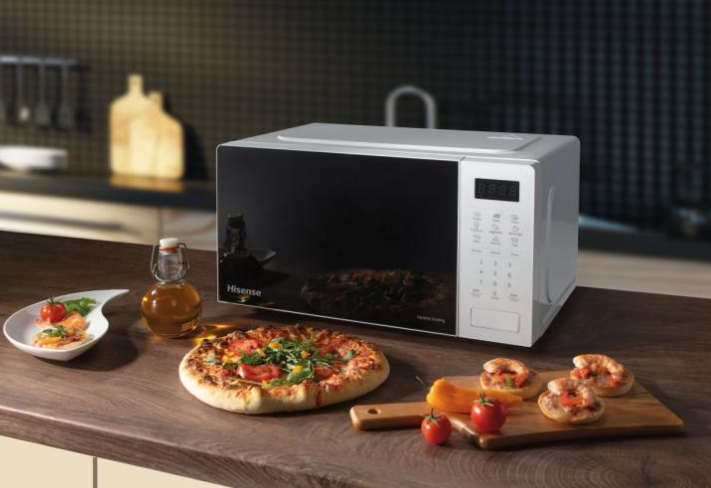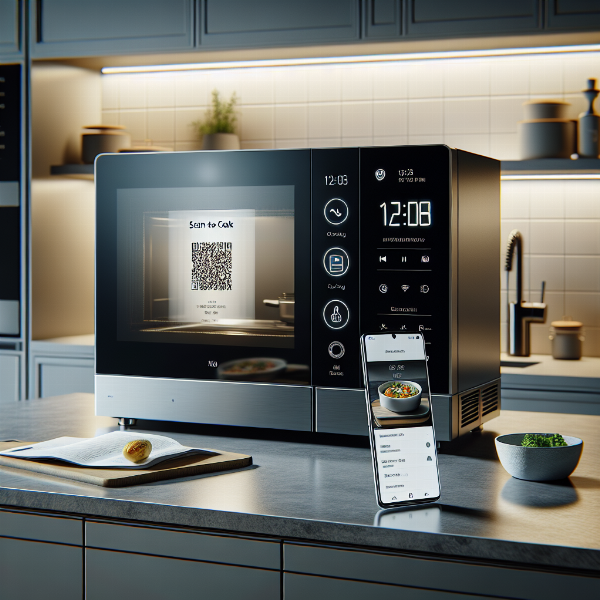Welcome to the future of the kitchen, where even the humble microwave is getting a high-tech upgrade. If you’re browsing the aisles or scrolling online, you’ve likely come across these new-age appliances. This in-depth Smart Microwave Oven Review is designed to cut through the marketing jargon and help you decide if this connected gadget is the right fit for your countertop. We’ll break down what these machines can do, weigh the pros and cons, and give you the real-world advice you need from your trusted source, MicrowaveOvenTop.com.
So, what exactly turns a regular microwave into a “smart” one? In a nutshell, it’s all about connectivity. A smart microwave connects to your home’s Wi-Fi network, allowing it to communicate with other devices like your smartphone, tablet, or smart home assistants like Amazon Alexa and Google Assistant. This connection unlocks a new level of convenience and control that traditional microwaves simply can’t offer. But is it a kitchen revolution or just another gadget to manage? Let’s dive in.
What Can a Smart Microwave Actually Do?
Beyond simply reheating leftovers, smart microwaves pack a suite of features designed to streamline your cooking process. While specific functions vary by brand and model, here are the core capabilities you’ll typically find.
- Voice Control: This is often the biggest selling point. By syncing with Alexa or Google Assistant, you can operate your microwave hands-free. Imagine saying, “Alexa, microwave for 90 seconds on high,” while your hands are covered in dough. It’s a small luxury that can make a big difference during a busy cooking session.
- Smartphone App Integration: Every smart microwave comes with a companion app. From this app, you can start or stop cooking, adjust power levels, and receive notifications when your food is ready—even if you’re in another room. Some apps also offer libraries of recipes with pre-programmed cooking instructions.
- Scan-to-Cook Technology: This feature takes the guesswork out of cooking pre-packaged foods. You simply use your phone’s camera to scan the barcode on the food’s packaging, and the app sends the precise cooking time and power level directly to the microwave. No more squinting at tiny instructions!
- Automated Cooking & Sensor Technology: Many smart models use advanced sensors to detect humidity and temperature, automatically adjusting cooking time to prevent over- or under-cooking. This is especially useful for things like popcorn, baked potatoes, and reheating dinner plates.
- Software Updates & Diagnostics: Because they’re connected, manufacturers can push software updates to improve performance or add new features over time. The app can also help diagnose problems, potentially saving you a call to a repair technician.

A modern kitchen setting with a person speaking to their Amazon Echo device to control their sleek, stainless steel smart microwave oven.
Our In-Depth Smart Microwave Oven Review: The Pros and Cons
Like any piece of technology, smart microwaves have their brilliant moments and their frustrating quirks. To give you a balanced view, we’ve broken down the key advantages and disadvantages.
The Bright Side (Pros)
- Unmatched Convenience: The ability to control your microwave with your voice or phone is a genuine time-saver. It’s perfect for multitasking parents, tech enthusiasts, or anyone who values efficiency in the kitchen.
- Precision Cooking: Features like scan-to-cook and sensor cooking lead to more consistent and better-tasting results. You’re less likely to end up with a frozen-in-the-middle, burnt-on-the-edges meal.
- Helpful for All Abilities: Voice commands can be a fantastic accessibility feature for individuals with mobility or visual impairments, making the kitchen a more independent space.
- A “Future-Proof” Appliance: With the ability to receive software updates, your microwave can potentially get better over time, gaining new functionalities that weren’t available when you first bought it.
As kitchen technology specialist Javier Rodriguez notes, “The real magic of a smart microwave isn’t just about remote starting. It’s about data. The scan-to-cook feature uses a massive database to cook food exactly as the manufacturer intended. It removes human error, which is the cause of most microwave mishaps.”
The Potential Pitfalls (Cons)
- The Price Tag: Smart features come at a premium. You can expect to pay significantly more for a Wi-Fi-enabled microwave compared to a standard model with similar wattage and size.
- Reliance on Wi-Fi: If your internet goes down, your smart microwave essentially becomes a “dumb” one. You lose all the connected features and are left with the basic keypad functions.
- Complexity and Glitches: More technology means more potential points of failure. Apps can be buggy, connections can drop, and software updates can occasionally cause problems. Sometimes, just pressing a button is faster and more reliable than opening an app or issuing a voice command.
- Privacy Concerns: Any device connected to the internet carries a potential privacy risk. It’s important to choose a reputable brand that takes security seriously and to secure your home Wi-Fi network.
Key Factors to Consider Before You Buy
Ready to make a decision? Before you click “add to cart,” run through this checklist to ensure you’re choosing the best smart microwave for your needs.
- Connectivity & Ecosystem: Does it work with your preferred smart home assistant (Alexa, Google Assistant)? Check for compatibility to ensure it integrates smoothly with your existing setup.
- The App Experience: Look up reviews of the microwave’s companion app in the App Store or Google Play. An intuitive, reliable app is crucial. A clunky, bug-ridden app will make the “smart” features more of a hassle than a help.
- Core Microwave Performance: Don’t get blinded by the tech! It still needs to be a great microwave. Look at the essentials:
- Wattage: Higher wattage (1000W or more) means faster, more even cooking.
- Size (Cubic Feet): Ensure it’s large enough for your typical dishes and cookware.
- Turntable: Does it have one? Can it be turned off for larger, rectangular dishes?
- Longevity and Maintenance: Smart components add another layer of complexity. Look for a solid warranty, especially on the electronic parts.
From a maintenance perspective, seasoned appliance technician Susan Miller advises, “I’m seeing more calls for connectivity issues than for heating problems on these new models. My advice is simple: before you buy, restart your home router. If your phone or laptop struggles to reconnect, a smart microwave will too. A strong, stable Wi-Fi signal is non-negotiable for these appliances.”
 A close-up shot of a person’s hand holding a frozen meal box, scanning the barcode with a smartphone before placing it in a smart microwave oven.
A close-up shot of a person’s hand holding a frozen meal box, scanning the barcode with a smartphone before placing it in a smart microwave oven.
The Verdict: Is a Smart Microwave Worth It?
So, after this comprehensive smart Microwave Oven review, what’s the final word? A smart microwave is worth it if you fall into one of these categories: you’re a dedicated tech enthusiast who loves building a connected home, you frequently cook pre-packaged meals and would benefit from scan-to-cook precision, or you would find voice commands genuinely helpful for accessibility or multitasking.
However, if you primarily use your microwave for simple tasks like reheating coffee or making popcorn, the extra cost and potential complexity may not be justified. A high-quality conventional microwave can perform those core functions just as well for a fraction of the price. The best choice ultimately depends on your lifestyle, budget, and how much you value high-tech convenience in your daily routine.
Frequently Asked Questions (FAQ)
1. Can a smart microwave work without a Wi-Fi connection?
Yes, absolutely. If you lose your internet connection or choose not to connect it, a smart microwave will function as a standard microwave. You will be able to use the keypad to manually enter times and power levels, but you will lose all voice control, app, and scan-to-cook features.
2. Are smart microwaves a security risk?
Like any internet-connected device, they carry a small risk. To minimize this, buy from a reputable manufacturer known for providing security updates, use a strong and unique password for your home Wi-Fi network, and avoid connecting the appliance to public or unsecured networks.
3. What is the main benefit of a smart microwave over a regular one?
The main benefit is convenience and precision. Features like voice control, remote operation via a smartphone app, and scan-to-cook technology are designed to make cooking simpler, faster, and more foolproof than what is possible with a standard microwave.
4. How much more does a smart microwave cost?
Typically, you can expect to pay anywhere from 50% to 150% more for a smart microwave compared to a non-smart model with similar size, power, and basic features. The price difference depends heavily on the brand and the specific smart features included.
5. Do I really need a smart microwave?
Need? Probably not. Want? Maybe! If you value convenience, love integrating technology into your home, and feel its advanced features will simplify your daily routine, it can be a great investment. If you prefer simplicity and just need basic reheating, a standard model is likely a more practical choice.